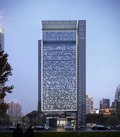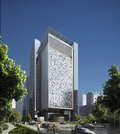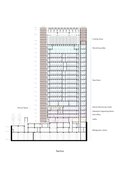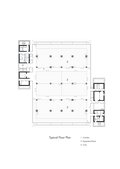TCC Qianhai Telecommunication Center, Shenzhen, China


© schneider+schumacher
Shenzhen Qianhai Telecommunication Center will become the world‘s first high-rise data center. In fast developing cities, land prices are sky-rocketing. Therefore it is common to build high-rises for offices and residential buildings. Now this principle is being applied to data centers, which are usually designed with only one or two floors, taking up huge site areas as the infrastructure – a windowless block that fails to relate to its urban surroundings.
schneider+schumacher


The 16 cooling towers on the roof ensure the smooth operation of the data center and the underground cooling stations.
© schneider+schumacher
The Qianhai Telecommunication Center in Shenzhen is destined to become the world’s first high-rise data centre. In fast developing cities, plot prices are sky-rocketing. This means that it is common to build high-rises for offices and residential buildings. Now this principle is also being applied to data centres, which are usually designed as low-rise buildings with only one or two floors, taking up huge plot areas.
Such a building would normally resemble a giant machine – a windowless block, that fails to relate to its urban surroundings. To compensate for this lack of interaction, here the lower floors have been planned as an inviting, airy lobby area, integrating a post office too. Its presence ensures that the building will contribute to the public life of Shenzhen. The majority of storeys will house computer rooms, with up to 3515 data units. Controlling units are located on the top floor. IT staff will be able to control all the data traffic from this floor, and since the employees in the building need to have a good working environment too, the architects’ solution was to provide a huge terrace on the 16th floor, offering employees there both daylight and a view of the city and the bay area.
Another important aspect of how the building integrates into its surroundings was to ensure an attractive appearance. The architects had to come up with a special design for the mainly windowless façade, and this has resulted in a spectacular external cladding system, which incorporates movable elements. It shows the binary code of the universal number Pi (π) – thus reflecting the building’s computational theme – where the 0‘s have been designed to move with the wind, creating a lively and interactive façade. At the same time, this cladding reflects the sunlight and provides a buffer zone to prevent heat reaching the building, thereby helping to maintain a cool climate for the computers inside. Another important feature helping to keep the building cool is the roof surface. Its shape is designed to create a larger air-flow between the roof and the cooling units, thus saving energy that would otherwise be needed for cooling.


© schneider+schumacher


© schneider+schumacher


© schneider+schumacher
The building’s continually changing façade can already be seen shimmering in the sunlight and glowing at night. When complete, the facade will display the universal number Pi in its binary composition of 0 and 1. Movement in the facade is provided by modules representing the digit 0, which, stimulated by the wind, can swing up to 6 degrees in both the horizontal and vertical axis. The digit 1, on the other hand, remains immobile, and is denoted by empty space in the anodised aluminium façade.


© schneider+schumacher


© schneider+schumacher
| Construction time / duration |
2018-2024 |
| Project type |
data canter / Infrastructure |
| Client |
Shenzhen Qianhai Development Investment Holding Co., Ltd. |
| Architects |
schneider+schumacher |
| Planning experts |
facade experts Cima |

















